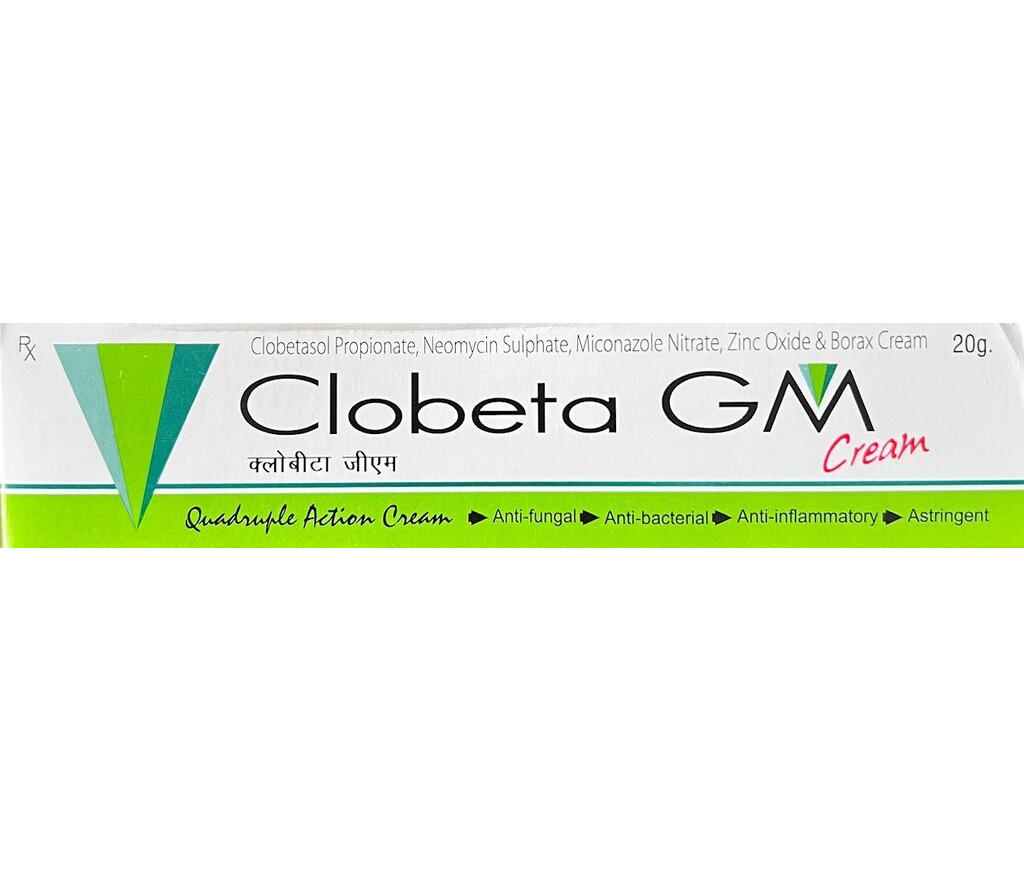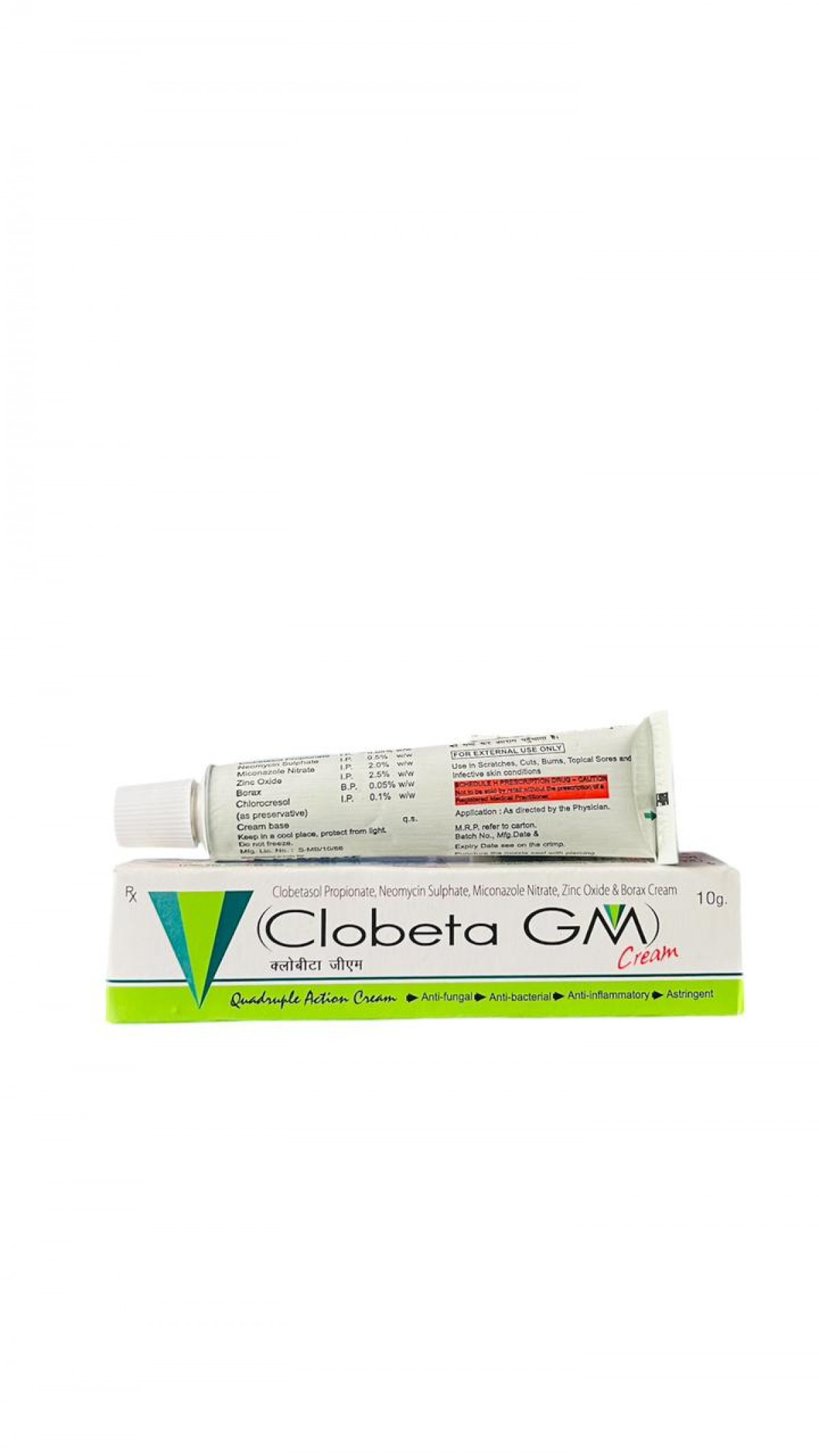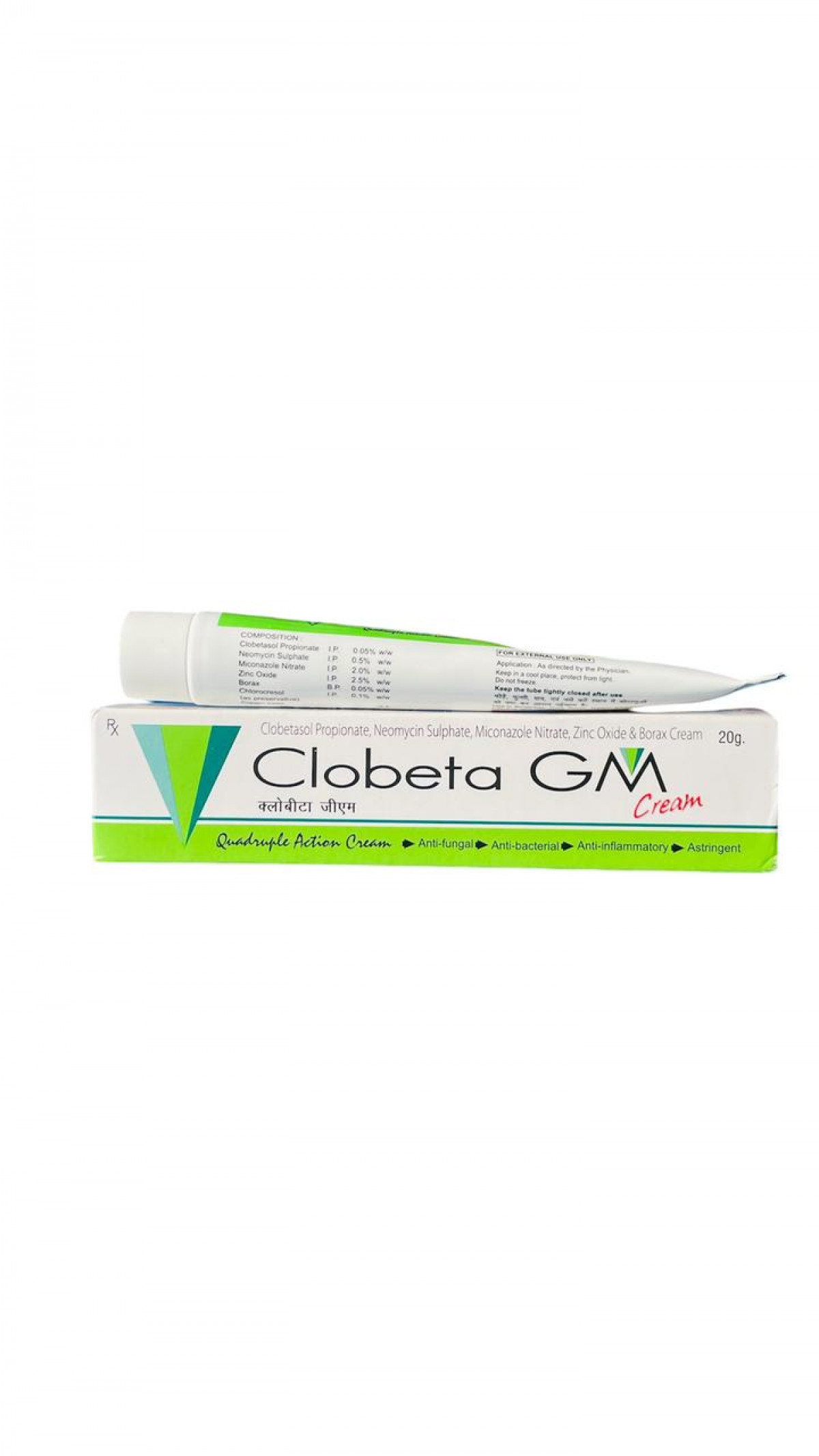Uses / Indications:
Clobeta-GM Cream is used to treat skin problems that include a mixed (or suspected mixed) infection component and are very inflamed, such as:
Eczema, dermatitis, or psoriasis exacerbated by a secondary bacterial or fungal infection.
Intertrigo (areas of skin folds)
Skin infections caused by fungi and bacteria on the surface
Lesions that are red, itchy, and ooze pus are inflamed.
Pregnancy interaction:
There isn't a lot of information about how safe Clobeta-GM Cream is for pregnant women.
The clobetasol part (a topical corticosteroid) is usually thought to be in category C (risk cannot be ruled out), which means that it should only be used when the benefits outweigh the risks.
Medical News Today
Some sites, like the NHS, say that when corticosteroids are put on the skin, very little of them gets into the bloodstream, thus the risk to the fetus is low. However, caution is still suggested.
nhs.uk
There is no strong evidence from the few studies that using topical corticosteroids during pregnancy increases the chance of birth abnormalities or miscarriage. However, using strong steroids like clobetasol for a long time is more worrying.
MotherToBaby
Again, there isn't much information available about nursing. Be careful not to put the cream on your breasts or nipples or anywhere else the baby could lick.
Drugs
If you are pregnant, trying to get pregnant, or breastfeeding, let your dermatologist or doctor know. You should only take the medicine if you really need to, on small regions, at the lowest dose that works, and for the shortest time possible.
Expert advice:
With steroid creams, potency and duration are very important. Use the lowest potency for the shortest amount of time.
Don't use too much—applying to big parts of the body, covering it up, or using it for a long time increases the chance of absorption and negative effects.
Keep an eye on the area that was treated. If the skin condition doesn't get better in a fair amount of time (like 1–2 weeks) or gets worse, go back to your doctor for a new evaluation.
If you're worried about getting pregnant or breastfeeding, you might want to use milder topical treatments that have been shown to be safe.
Don't mix with other topical medications that are comparable unless your doctor tells you to. This is to avoid getting too much steroids or having them interact with each other.
Regular follow-up is important, especially for long-term medication. Look for evidence of local skin thinning, changes in pigmentation, or other bad consequences.
Teach patients how to use the product correctly (apply a thin coating, don't apply it to fresh wounds, wash their hands, and stay away from sensitive regions).
Side Effects:
Clobeta-GM might produce negative effects, just like all other drugs. Many of them are moderate and local; significant systemic effects are unlikely if the drug is administered correctly and for a short time.
Side effects that happen often or in the area
Medicover Hospitals , and more say that the application site may feel burning, stinging, tingling, or irritated.
Skin that is red, dry, peeling, or flaking
Thinning of the skin (atrophy) after lengthy use
Medicover Hospitals
Changes in skin color or discoloration
Uncommon allergic reactions include rashes, hives, and swelling.
Secondary illnesses if used too much or incorrectly
Less common or systemic dangers, especially with long-term usage, use over a vast region, or use under occlusion.
Taking corticosteroids can make the adrenal glands in that area work less well.
In rare instances, systemic corticosteroid effects manifest as Cushing’s syndrome, elevated blood glucose levels, and impacts on other endocrine axes.
Resistance or toxicity from an antibiotic component if it is abused
Worsening of current illnesses or the emergence of a superinfection
If you discover that your face is swelling, you are unusually tired, your skin condition is getting worse, or you have signs of systemic effect, stop taking it and talk to your doctor.
How to use:
Route: just topical (external)
Before applying, clean and dry the region that is affected gently.
Amount: Put a thin layer of cream on the skin that is afflicted (the area that is inflamed or infected).
How often: Usually once or twice a day, or as your doctor says to.
Duration: Only use for the time period specified; avoid using for a lengthy duration, especially with strong corticosteroids.
After using, wash your hands (unless they are part of the area that was treated).
Don't use it on open wounds, broken skin, mucous membranes (such the inside of the nose, mouth, or vagina), or eyes. If you come into contact with it, rinse it off right away with water.
If you forget a dose, take it as soon as you remember, but not if it's almost time for the following dose (don't take two doses). You should not use too much; if you do, wash it off and see a doctor.
How it works:
Clobetasol acts by stopping the inflammatory response (stopping mediators, lowering edema, redness, and itching).
Miconazole works against fungus by blocking the creation of ergosterol, which is a part of the fungal cell membrane.
Neomycin stops bacteria from making proteins, which kills or stops them from growing.
The combination lets you reduce inflammation and both bacterial and fungal elements in mixed skin infections at the same time.
Medicover Hospitals: +3 Truemeds: +3 Truemeds: +3
Uses and indications
Clobeta-GM Cream is used to treat skin problems that include a mixed (or suspected mixed) infection component and are very inflamed, such as:
Eczema, dermatitis, or psoriasis exacerbated by a secondary bacterial or fungal infection.
Faq for medicine:
Q. Is it safe to use Clobeta-GM Cream when pregnant?
A. There isn't much safety data. Only use if absolutely necessary and under the care of a doctor. It should only be applied on tiny areas for a short time.
Drugs.com +4, PharmEasy +4, Practo +4
Q. Is it okay to use when breastfeeding?
A. It can be used, but with caution. Don't put it on or near the breast or nipples, or anywhere the infant can reach.
PharmEasy +1
Q. Is this cream safe for kids?
A. There hasn't been as much research on how safe it is for kids, especially young ones. Don't give this to kids under a specific age unless a doctor tells you to.
Truemeds +3
PharmEasy +3 Practo +3
Q. Is it okay to apply it on my face or genitals?
A. It's usually not a good idea to apply on the face, genitals, perianal area, or mucous membranes because the skin is thinner there and the danger of irritation or systemic absorption is higher.
PharmEasy +1
Q. How long does it take to get results?
A. The exact start time isn't known, although patients usually notice less irritation, itching, or redness within a few days if the ailment is receptive.
Practo +1
Q. What should I do if I have adverse effects?
A. If you have burning, deteriorating skin, allergic reactions, or other systemic symptoms, stop using it and talk to your doctor.
Q. How do you keep it?
A. Keep it at room temperature (usually less than 25 °C) and out of direct sunlight, dampness, and reach of kids.
PharmEasy +1
Medicine interaction:
Because Clobeta-GM is a topical preparation, systemic interactions are less expected. However, there may be some possible interactions or warnings:
With other topical agents: It is important to keep an eye on the use of other topical corticosteroids, antifungals, or antibiotics at the same time (cumulative effects, irritation).
Oral antifungals / systemic medications: The miconazole part might theoretically influence systemic pharmaceuticals that are broken down in the same way, however since absorption is modest, interactions are usually small. Some sites warn that the antifungal part could make oral hypoglycemic drugs work better (which could cause low blood sugar) or interact with anticoagulants (like warfarin), however there isn't much proof for this.
Truemeds
Corticosteroids: If you are still getting systemic corticosteroid medication, the effects of corticosteroids may be stronger.
Other systemic drugs: Not likely to be important unless they are absorbed a lot.
Always tell your doctor about all the other medicines you're taking, whether they're pills, creams, or herbal remedies. This way, they can check for interactions.




